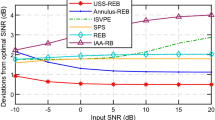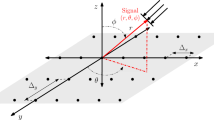Abstract
Temporal filters and spatial filters are widely used in many areas of signal processing. A number of optimal design criteria to these problems are available in the literature. Various computational techniques are also presented to optimize these criteria chosen. There are many drawbacks in these methods. In this paper, we introduce a unified framework for optimal design of temporal and spatial filters. Most of the optimal design problems of FIR filters and beamformers are included in the framework. It is shown that all the design problems can be reformulated as convex optimization form as the second-order cone programming (SOCP) and solved efficiently via the well-established interior point methods. The main advantage of our SOCP approach as compared with earlier approaches is that it can include most of the existing methods as its special cases, which leads to more flexible designs. Furthermore, the SOCP approach can optimize multiple required performance measures, which is the drawback of earlier approaches. The SOCP approach is also developed to optimally design temporal and spatial two-dimensional filter and spatial matrix filter. Numerical results demonstrate the effectiveness of the proposed approach.
Similar content being viewed by others
References
Van Veen, B. D., Buckley, K. M., Beamforming: A versatile approach to spatial filtering, IEEE ASSP Magazine, 1988, 5(2): 4–24.
Oppenheim, A. V., Schafer, R. W., Disctete-time Signal Processing, Englewoods Cliffs, NJ: Prentice-Hall, 1989.
Rabiner, L. R., Gold, B., Theory and Application of Digital Signal Processing, Englewoods Cliffs, NJ: Prentice-Hall, 1975.
Widrow, B., Stearns, S. D., Adaptive Signal Processing, Englewood Cliffs, NJ: Prentice-Hall, 1985.
Zhang, X., Dai, S., Designs of Chebyshev-type complex FIR filters and digital beamformers with linear-phase characteristics, IEE Proceedings-Vision, Image and Signal Processing, 1994, 141(1): 2–8.
Lertniphonphun, W., McClellan, J. H., Complex frequency response FIR filter design, in Proc. ICASSP’98, Seattle, WA, USA, 1998, 3: 1301–1304.
Zhu, W. P., Ahmad, M. O., Swamy, M. N. S., A new approach for weighted least-square design of FIR filters, in Proc. ISCAS’99, Orlando, FL, USA, 1999, 3: 267–270.
Burrus, C. S., Barreto, J. A., Selesnick, I. W., Iterative reweighted least-squares design of FIR filters, IEEE Trans. Signal Processing, 1994, 42(11): 2926–2936.
Lang, M., Bamberger, J., Nonlinear phase FIR filter design according to the L2 norm with constraints for the complex error, Signal Processing, 1994, 36(1): 31–40.
Dam, H. H., Teo, K. L., Nordebo, S., Cantoni, A., The dual parameterization approach to optimal least square FIR filter design subject to maximum error constraints, IEEE Trans. Signal Processing, 2000, 48(8): 2314–2320.
Adams, J. W., FIR digital filters with least-squares stopbands subject to peak-gain constraints, IEEE Trans. Circuits and Systems, 1991, 39(4): 376–388.
Er, M. H., Siew, C. K., Design of FIR filters using quadratic programming approach, IEEE Trans. Circuits and Systems II: Analog and Digital Signal Processing, 1995, 42(3): 217–220.
Dolph, C. L., A current distribution for broadside arrays which optimizes the relationship between beamwidth and sidelobe level, Proc. IRE, 1946, 34(6): 335–348.
Ma, Y. L., Beampattern optimization for arbitrary geometry sensor arrays, Shipbuilding of China (in Chinese), 1984, 87(4): 78–85.
Olen, C. A., Compton, R. T. Jr., A numerical pattern synthesis algorithm for arrays, IEEE Trans. Antennas Propagat., 1990, 38(10): 1666–1676.
Nordebo, S., Zang, Z., Claesson, I., A semi-infinite quadratic programming algorithm with applications to array pattern synthesis, IEEE Trans. Circuits and Systems II, 2001, 48(3): 225–232.
Ng, B. P., Er, M. H., Kot, C., A flexible array synthesis method using quadratic programming, IEEE Trans. Antennas Propagat., 1993, 41(11): 1541–1550.
Wu, L., Zielinski, A., Equivalent linear array approach to array pattern synthesis, IEEE J. Ocean. Eng., 1993, 18(1): 6–14.
Wu, L., Zielinski, A., An iterative method for array pattern synthesis, IEEE J. Ocean. Eng., 1993, 18(3): 280–286.
Zhou, P. Y., Ingram, M. A., Pattern synthesis for arbitrary arrays using an adaptive array method, IEEE Trans. Antennas Propagat., 1999, 47(5): 862–869.
Zhu, W. J., Sun, J. C., Zeng, X. Y., Adaptive synthesis method for broadband array with frequency invariant beam pattern, Chinese Journal of Acoustics, 2003, 22(4): 352–359.
Capon, J., High-resolution frequency-wavenumber spectrum analysis, Proc. IEEE, 1969, 57(8): 1408–1418.
Cox, H., Zeskind, R. M., Kooij, T., Practical supergain, IEEE Trans. Acoust., Speech, Signal Processing, 1986, 34(3): 393–398.
Cox, H., Zeskind, R. M., Owen, M. M., Robust adaptive beamforming, IEEE Trans. Acoust., Speech, Signal Processing, 1987, 35(10): 1365–1376.
Carlson, B. D., Covariance matrix estimation errors and diagnonal loading in adaptive arrays, IEEE Trans. Aerospace Electron. Syst., 1988, 24(4): 397–401.
Song, H., Kuperman, W. A., Hodgkiss, W S. et al., Null broadening with snapshot-deficient covariance matrices in passive sonar, IEEE J. Oceanic Eng., 2003, 28(2): 250–261.
Lobo, M., Vandenberghe, L., Boyd, S. et al., Applications of second-order cone programming, Linear Algebra Applicat., 1998, 284(1–3): 193–228.
Yan, S. F., Ma, Y. L., A unified framework for designing FIR filters with arbitrary magnitude and phase response, Digital Signal Processing, 2004, 14(6): 510–522.
Gao, H. J., Wang, C. H., New approaches to robust l 2-l ∞ and H∞ filtering for uncertain discrete-time systems, Science in China, Series F, 2003, 46(5): 355–370.
Vandenberghe, L., Boyd, S., Semidefinite programming, SIAM Review, 1996, 38(3): 49–95.
Sturm, J. F., Using SeDuMi 1.02, a MATLAB toolbox for optimization over symmetric cones, Optim. Meth. Softw., 1999, 11–12(1–4): 625–653.
Yan, S. F., Ma, Y. L., Sun, C., Optimal beamforming for arbitrary arrays using second-order cone programming, Chinese Journal of Acoustics, 2005, 24(1): 1–9.
Yan, S. F., Ma, Y. L., Frequency invariant beamforming via optimal array pattern synthesis and FIR filters design, Chinese Journal of Acoustics, 2005, 24(3): 202–211.
Tao, H. H., Yu, J., Wang, H. Y. et al., A novel space-borne antenna anti-jamming technique based on immunity genetic algorithm-maximum likelihood, Science in China, Series F, 2005, 48(3): 397–408.
Yan, S. F., Ma, Y. L., Frequency invariant beamforming via jointly optimizing spatial and frequency responses, Progress in Natural Science, 2005, 15(4): 368–374.
Ma, Y. L., Liu, M. A., Zhang, Z. B. et al., Receiving response of towed line array to the noise of the tow ship in shallow water, Chinese Journal of Acoustics, 2003, 22(1): 1–10.
Baggeroer, A. B., Kuperman, W. A., Mikhalevsky, P. N., An overview of matched field methods in ocean acoustics, IEEE J. Ocean. Eng., 1993, 18(4): 401–424.
Ma, Y. L., Yan, S. F., Yang, K. D., Matched field noise suppression: Principle with application to towed hydrophone line array, Chinese Science Bulletin, 2003, 48(12): 1207–1211.
Poter, M. B., The KRAKEN normal mode program, SACLANTCEN Memo, SM-245, 1991.
Yan, S. F., Ma, Y. L., Matched field noise suppression: A generalized spatial filtering approach, Chinese Science Bulletin, 2004, 49(20): 2220–2223.
Gingras, D. F., Gerstoft, P., Inversion for geometric and geoacoustic parameters in shallow water: Experimental results, J. Acoust. Soc. Am., 1995, 97(6): 3589–3598.
Author information
Authors and Affiliations
Corresponding author
Rights and permissions
About this article
Cite this article
Yan, S., Ma, Y. Optimal design and verification of temporal and spatial filters using second-order cone programming approach. SCI CHINA SER F 49, 235–253 (2006). https://doi.org/10.1007/s11432-006-0235-3
Received:
Accepted:
Issue Date:
DOI: https://doi.org/10.1007/s11432-006-0235-3




